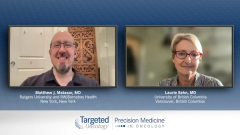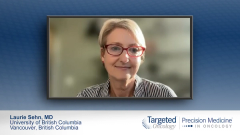
First-Line Treatment Strategies in Follicular Lymphoma
Centering discussion on both symptomatic and asymptomatic disease, expert participants highlight cornerstone frontline therapies in follicular lymphoma.
Episodes in this series

Transcript:
Matthew J. Matasar, MD: This is perhaps a good segue to talk about how you go about thinking through treatment choices for a patient with newly diagnosed follicular lymphoma, how you view the role for active observation in the modern era, and for patients who do need treatment, how you would go about working with that patient to determine the best course of action.
Laurie Sehn, MD: It’s very important to stage patients appropriately upfront at the time of diagnosis. In my own clinic that involves, in addition to questioning and physical examination, a series of blood tests, including LDH [lactate dehydrogenase], which can be elevated in follicular lymphoma with enough disease burden but could also be an indicator that you might have an occult transformation, for example. PET [positron emission tomography] CT [computed tomography] scanning would be considered standard and valuable at this point to identify areas of disease. I think what’s a little more controversial is the role of bone marrow biopsy at the time of diagnosis. We tend to still do them. There’s fairly good data to suggest that PET scanning can be quite sensitive for picking up follicular lymphoma in the bone marrow, although there’s no question that it probably misses some patients with lower burden disease. So for the time being, we’ve continued to incorporate it as part of our staging system, but I know that people are starting to drop it from their own practice. I’m curious, have you been doing bone marrow biopsies routinely as part of your staging as well, or have you started to drop it?
Matthew J. Matasar, MD: I’ll say that it’s the minority of patients that I see that require bone marrow biopsy as part of their initial staging. I typically reserve it for patients whom I suspect has limited-stage disease and may benefit from radiotherapy, to exclude advanced-stage disease, or if a patient has unexplained cytopenias that require elaboration. So for me, it’s really only being done if I have a clinical decision that’s going to be informed by the results of the marrow, as opposed to staging for staging’s sake.
Laurie Sehn, MD: I think that practice is tending to go in that way as well. What I would say is that once patients are staged, it’s about 15% of patients or so who probably fall in that category that we would call localized or limited-stage disease who’d be amenable to treatment with involved-field radiation. Those patients are still generally recommended to go down the radiation route, because we know that about 50% of them will remain disease-free for the rest of their lifetime. So, are they cured? They’re either cured, or their disease is sufficiently treated and it’s indolent enough that it never emerges again in their lifetime. In general, as long as it’s an area that’s amenable to radiation without a lot of toxicity, that would still be the recommendation for patients with limited-stage, radiation-incompossible disease. That’s only about 15% of patients.
The remaining patients present with disease that is not appropriate for a localized approach. In those patients, it’s still fair to divide them to what we call sometimes asymptomatic, or symptomatic advanced-stage patients, based on whether or not they have clinical symptoms being caused by their lymphoma, and particularly whether or not they have enough burden of lymphoma that requires treatment. Those patients who we consider asymptomatic, we typically had referred to them as the watch and wait, or observation patients. In that group of patients, I would say that the big conflict these days is, do you just recommend observation, or would you consider single agent rituximab?
In my own clinic we were offering patients, pretty routinely, single agent rituximab as an alternative to a watch and wait or observation strategy. That treatment was justified based on clinical trial data that came out where we had 2 trials in the upfront setting of advanced asymptomatic patients with follicular lymphoma that looked at using rituximab only. One of those trials compared it against an observation approach. I think it’s fair to say that we don’t yet have a trial that proves any overall survival advantage of intervening, either with rituximab alone or chemotherapy for these asymptomatic patients, which justifies the use of observation. In the clinical trial that compared rituximab alone versus observation, the one potential advantage was the delay in needing chemotherapy. Treating a patient with asymptomatic disease upfront could potentially put off their need for chemotherapy. For how long? I think that as we see the data emerge from that in our own clinical experience, you’re probably buying patients years of time. We looked at the data here in British Columbia, and probably the median amount of time we were able to achieve was about 3 years of delaying chemotherapy.
While that was frequently one of our recommendations for patients, rather than observation, I think COVID-19 has drastically changed our use of treatment in asymptomatic advanced-stage patients. Currently, I think the risk of using rituximab and sort of reducing patients’ vaccine response with rituximab is higher than the risk of having advanced stage, low tumor burden, asymptomatic follicular lymphoma. So, in those patients who we would normally recommend watch and wait or observation, I think the pendulum has swung away from giving single-agent rituximab to watch and wait again because of the ongoing COVID-19 risk, and knowing that these patients are probably going to need booster vaccines along the way.
What about the other patients who actually need treatment? Well, I think it’s fair to say that, for advanced stage patients with symptomatic or higher tumor burden disease, the current standard of care, despite the fact that we would like to move to a chemotherapy-free based approach, still very much relies on chemotherapy as being the backbone of treatment.
Matthew J. Matasar, MD: Speaking of the implications of the impact of the ongoing COVID-19 pandemic on treatment, I completely agree that it really raises the threshold for initiating treatment, which could put patients at increased risk of either contracting or having complications of COVID-19. For me it also has implications for post-induction care, and whereas the use of maintenance therapy following first-line therapy has long been a subject of debate given the absence of overall survival benefit, I think in this COVID-19 area, for me, it really makes maintenance, monoclonal antibody therapy maintenance, rituximab maintenance, and obinutuzumab, even less attractive given those concerns that you just outlined.
Laurie Sehn, MD: I would say absolutely. We know that, as I said, chemo-immunotherapy still is the front-line standard of care for patients with follicular lymphoma needing treatment. Beyond chemo-immunotherapy, there is data to demonstrate that continuing rituximab in a maintenance way for 2 years does improve the progression-free survival, but not the overall survival. In my own clinic we have frequently offered patients maintenance rituximab after chemo-immunotherapy, and I have to say that, despite COVID-19, in that setting I still offer it, mainly because there’s fairly good data to suggest that we might actually double the progression-free survival that patients will see. But it involves a much more detailed discussion now. I also discuss with them the trade-offs, the risk of prolonged immunosuppression, the competing risk of COVID-19 and vaccine requirement. So I still continue to offer it as, what I would still consider in my mind, the better standard of care. I think there are competing risks now, and I know that it’s much more decided on a patient-by-patient basis with a frank discussion on that risk/benefit trade-off. Most of the time I’m now letting patients decide.
Matthew J. Matasar, MD: I guess this is an area where the fact that there can be multiple approaches to the data really underscores the uncertainty and the heterogeneity both of the disease and of clinical practice.
Transcript edited for clarity.










































